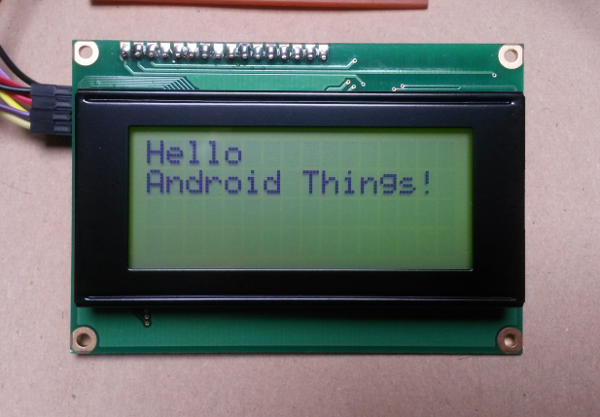I’ve written a tutorial on character LCD displays and how to drive them with Android Things. It’s on Hackster.io, check it out here.
Tag: Character LCD

Configure Android Things using BLE
In my last experiment I used the Android Things developer console to create a factory image for my bus stop project. I then created an OTA update to update the bus stop apk ‘in the field.’ I concluded that experiment wondering how I was going to get my network credentials onto the device (without using adb). If your device doesn’t have a touchscreen or keyboard how are you going to get it onto your end user’s network. One possible solution to this problem is to use a companion app on the user’s phone to collect configuration information. With a companion app you get all of the UI niceness provided by that platform for ‘free.’ You still need to get the configuration from the phone to your Android Things device. This is where Bluetooth Low Energy comes in.
Bluetooth Low Energy
Bluetooth Low Energy is exactly the kind of short range wireless technology that can help out here. It’s relatively easy to implement using Android APIs and there’s no need for the device to be on a network to configure it. I can start with the BLE sample for Android Things that has almost everything I’m going to need.
For my bus stop project I have two things to configure that require end user input. I need to configure which stop number I want to display bus data for. I also need to get it onto a network to get real-time bus schedule information from a web API.

Hello Android Things Developer Console
This week Google released the developer console for Android Things. With this release, another piece of the puzzle is in place. The terms and conditions of the developer console it make clear that this is a developer preview, the number of devices you can push updates to is limited to 500, and you can use the console “for the sole purpose of internal development and testing of devices.” Don’t go out and try to sell anything yet. It looks as though actually distributing a product will require an additional, commercial agreement with Google.
I used the developer console to create an image for my (now deprecated) iMX6UL Wandaboard (bought especially for Android Things development, not that I’m bitter about it being deprecated so soon). The process is simple enough. The hardest part is figuring out how much of the device’s memory to reserve for an OEM partition. I went for a wildly pessimistic 128MB partition size, which is over kill for a 2MB app, but once set the partition size cannot be changed so I erred on the cautious side.
I created a product based on my bus stop project.
In the first part of this series we set up some hardware to drive an LCD character display with the Raspberry Pi running the preview image of Android Things. In this part we will setup the project in Android Studio, import the driver library and write a message to the display.
Welcome to the first part in a two part series about using an LCD Character display with Android Things. In this part we’ll collect, partially explain, and wire together the hardware. In the next part we’ll setup the project in Android Studio and write some clever messages to the display.
The Android things I2C API enables you to communicate with I2C devices, such as the PCF8574, using java in an Android project. The PCF8574 is a port expander that lets you connect to peripherals over a relatively high speed serial bus to a controller. This reduces the wire count and pin usage. Common usage includes interfaces to buttons, keypads and displays. We will use the PCF8574 to connect a Raspberry Pi to an LCD Character display.

Character LCD driven by Android Things